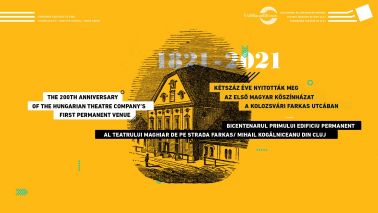12. 03. 2021
The 200th Anniversary of the Hungarian Theatre Company’s First Permanent Venue
The first permanent theatrical venue built for the first professional Hungarian theatre company named Erdélyi Nemzeti Játékszín (The National Theatre of Transylvania) opened its doors 200 years ago in Cluj, on Farkas / Kogălniceanu Street
The Beginnings of Hungarian Language Theatre in Cluj
On December 17, 1792, with the premiere of the play A titkos ellenkezés vagy Köleséri, the Nemzeti Játszó Társaság (National Acting Society) began performing its productions, thus launching a permanent Hungarian language theatre in Cluj. In October 1792, the noble young actors led by János Fejér, namely József Kontz, János Sáska, Pál Jantsó, Mihály Verestói, the siblings of János Fejér: István and Rozália, Terézia Kis, and Terézia Keszeg submitted a request to the royal governor and parliament allowing them to perform plays written in Hungarian, in Cluj and anywhere else in Transylvania. They were granted the request, in what was a more tolerant than enthusiastic reply. The aim of the noble young actors was not primarily to do comedy and entertain, but to thus enrich and refine the Hungarian language. They were soon joined by the very talented and cultured János Kótksi Patkó, which significantly raised the artistic standard of the first acting company. Kótsi soon became a defining and leading personality in the company. The young actors worked within the confines of their permission to find a venue for the performances. Countess Rhédey, née Baroness Terézia Bánffy, came to their rescue, by offering her ballroom free of charge for an entire year for this purpose.
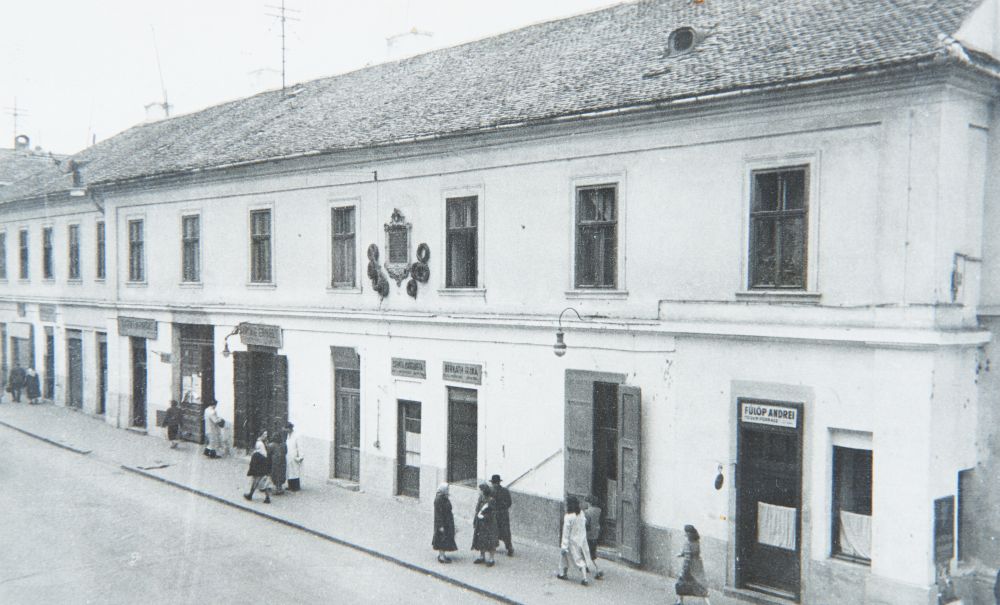
Rhédey House, the first venue of the Hungarian theatre in Cluj
Building the First Permanent Venue Dedicated to Hungarian Theatre
The enthusiastic young actors knew that what would ensure the most secure future for them would be to build a permanent venue, so already in 1793 they decided to build a theatre. The Teatralis Comissio was set up to manage the construction, but the construction itself encountered various obstacles. Nonetheless, in September 1803, the foundation stone of the building was laid, after 5 enthusiastic patriots: Count Ferenc Teleki, Baron Miklós Wesselényi, Baron József Thoroczkay, Count Lajos Teleki and Baron József Bánffy bought the parcel for 5,000 ft. from the Reformed College. Thanks to many other generous donors and craftsmen performing volunteer work, through countless difficulties, 28 years after the need for such an establishment arose, the first permanent Hungarian theatre was built, following the work of the architect Antal Alföldi from Cluj.
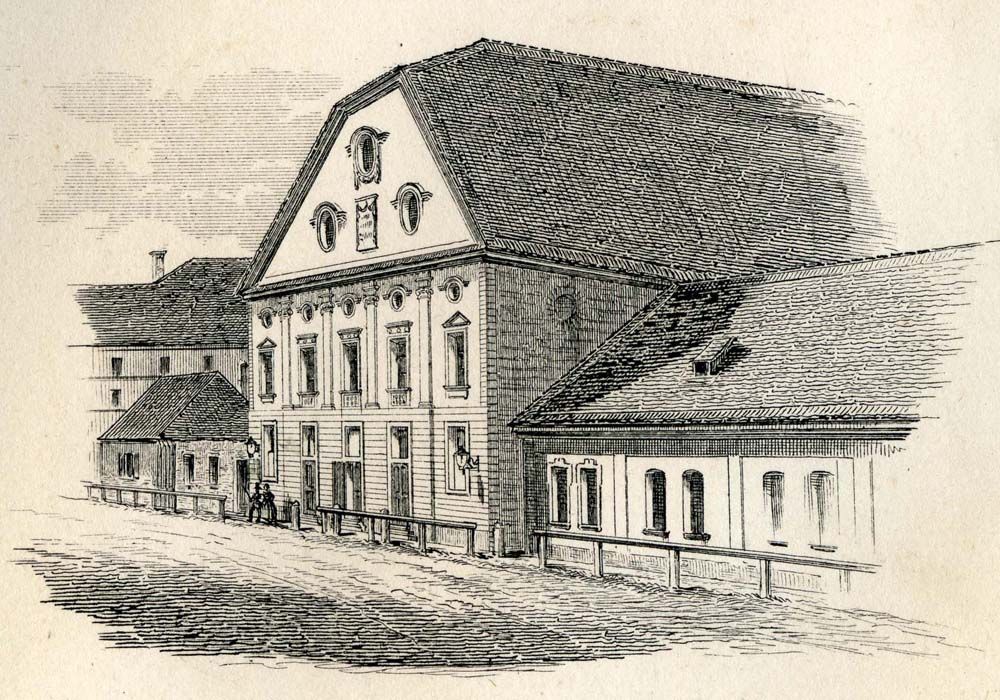
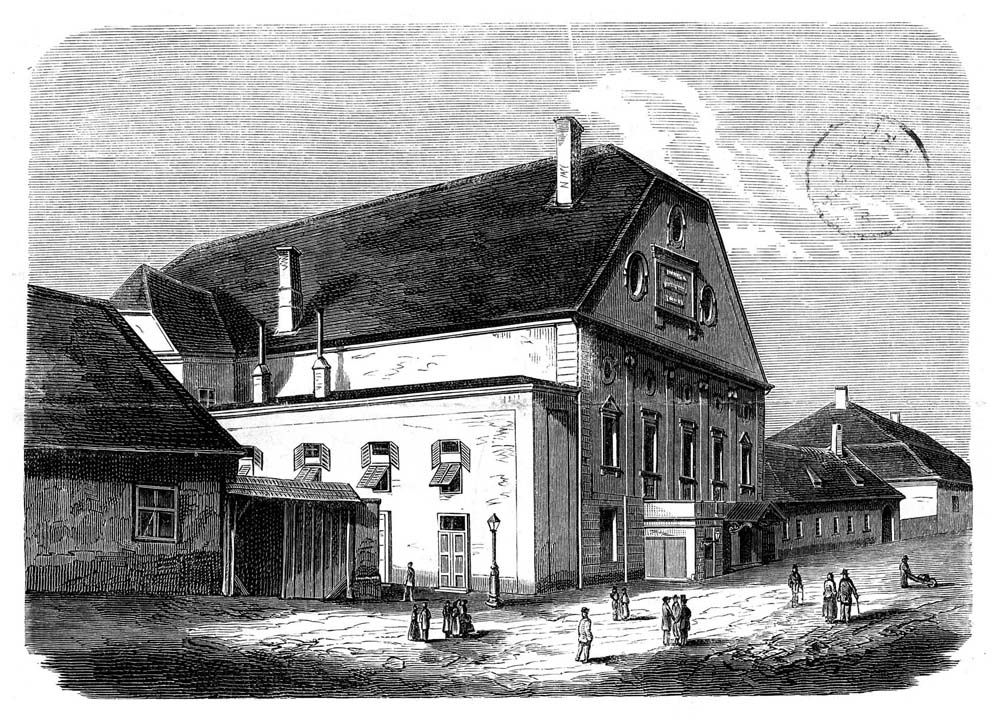
The Farkas / Kogălniceanu Street Theatre, in the 1850s The Farkas / Kogălniceanu Street Theatre, after the reconstruction in 1865
The First Performance on the Farkas/Kogălniceanu Street Stage
The grand opening of the first permanent venue of Hungarian theatre was held on Farkas/Kogălniceanu Street, on March 12 and 13, 1821, with two performances. On the first night, a group of actors made up of aristocratic amateur actors performed Teodor Körner’s tragedy entitled Zrinyi, and this carried an important message. The next day, on March 13, the Cluj theatre company presented a play written by László Szentjóbi Szabó entitled Mátyás király, vagy A nép szeretete a jámbor fejedelmek jutalma[1] (King Matthias or The Love of the People as the Reward for Pious Leaders). With their performance, the aristocratic actors reaffirmed their commitment to Hungarian language theatre. To the institution in whose venue they invested important sums of money for many years.
Körner's play was translated by Dániel Petrichevich Horváth, landowner, imperial-royal chief master, one of the patrons of Hungarian language theatre, who also portrayed the lead role in the play. He also wrote and recited the Prologue opening the festive evening. After the deeply patriotic and enthusiastic prologue, the students of the Cluj Music Association sang Zsigmond Komjátszegi Szentkirályi’s choral piece entitled A Nemzet Ünnepére az Erdélyi Magyar Játékszín kinyitásakor (Dedicated to the National Celebration on the Occasion of Opening the Hungarian Theatre in Transylvania). This was followed by a heroic play evoking the figure of Zrínyi, in which, in addition to Dániel P. Horváth, the following aristocrats also performed: Count József Csáky, Count Pál Bethlen, Barron József Bornemisza, Barron Miklós Bánffy, Gergely Barcsay, Lajos Lészai, Ménasági, Miklós Iszlai, Countess Csáky, Barroness Mária Inczédi, Count János Rhédei, Count János Teleki, Count Pál Bethlen, Sr., Count János Bethlen, Sámuel Deáky, Intze and Végheli. That evening, as on the following, the theatre was packed to full capacity and the performance was honored by the presence of the Governor of Transylvania, Count György Bánffy, accompanied by several Hungarian noblemen from the royal governance. It was an uplifting, touchingly successful evening. As a noble gesture, the aristocratic actors donated their expensive, ornate clothes sewn for the opening performance to the theatre.
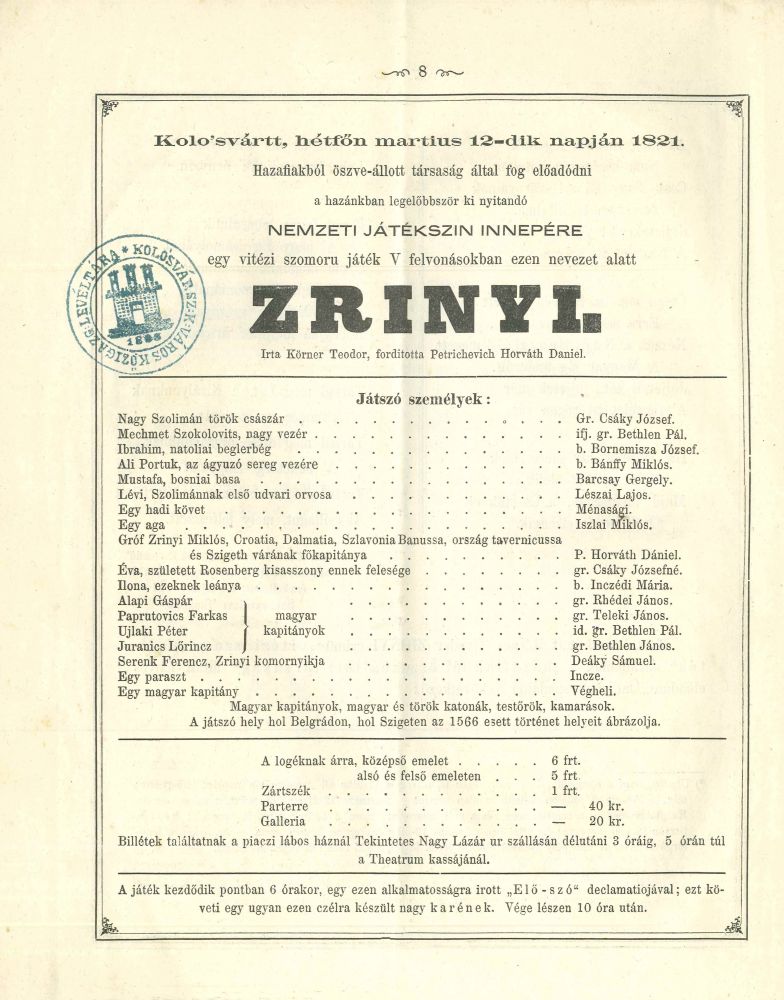
The poster of the performance presented by the aristocrats, which inaugurated the Farkas / Kogălniceanu Street Theatre
The First Performance Played by Professional Actors
On March 13, the second evening of the festive opening, the Transylvanian National Theatre Company, i.e. the professional actors, took to the stage. Since, to the best of our knowledge, no posters were preserved from that day, we will hence render the name of the company’s members at that time: József Székely and his wife, Anikó Székely Ungár, Pál Jantsó, Pergő Celesztin, Mária Néb, István Török, József Farkas, Borbára Simény, Borbára Hanjós Koronka, György Simonffy, who was also a stage manager and set painter, József Székely Jr., Juliánna Keresztes, Mária Técsi, Sándor Rácz, István Göde, László Kónya, Mojzes Bartha, as well as Pál Kolozsváry and Sándor Gillyén, who were also prompters. The intellectual life of the theatre was coordinated by the three leading actors, who were also directors: Pál Jantsó, Pergő Celesztin, and József Székely, Sr.. In addition, the Theatre Committee entrusted Pál Jantsó with the supervision of discipline and acting, József Székely Sr. was responsible for the observance of the theatre law and the costume storage, while Pergő Celesztin handled the library and the requisites needed for the plays themselves.
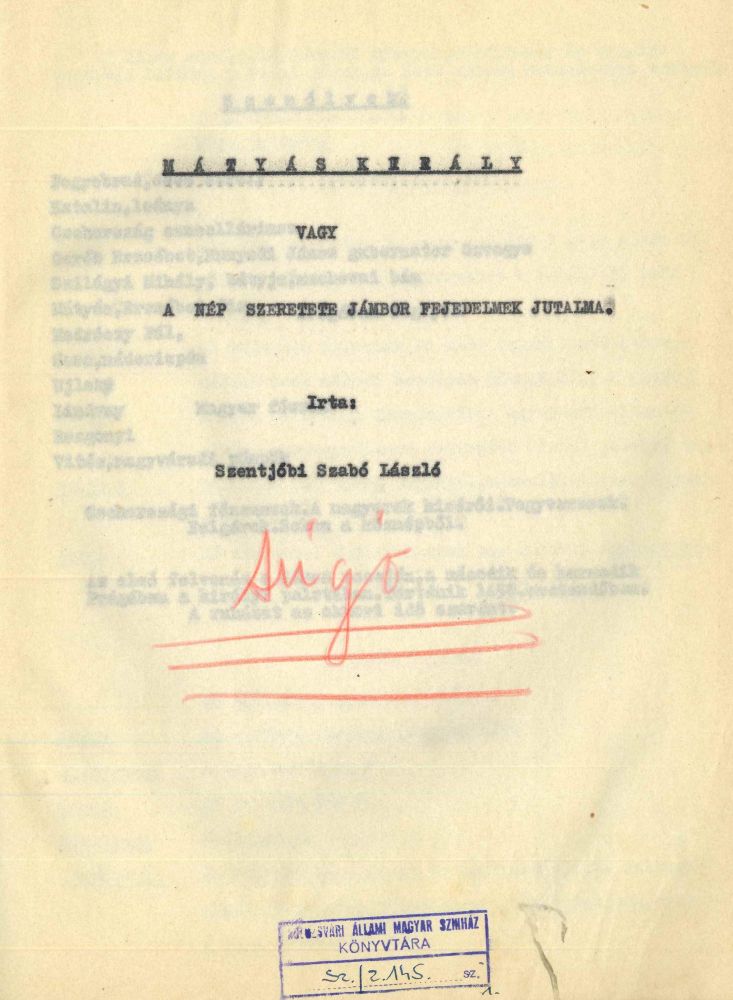
The script of the play performed by the professional actors
Theatrical Positions in 1821
In Emléklap, and his book[2] on the history of the theatre, published on the 50th anniversary of the opening of the permanent venue, Zoltán Ferenczi also recorded other names belonging to the staff of the theatre. Based on these, we can find out what professions were needed in the company at that time: Typographer - István Török, who printed the posters, Taylor - József Székely, Cashier - László Nagy, Seating attendant - Pál Szőnyi, Ticket attendant – Susanna Görög, Host and light technician - József Bajnovics and his wife, Stagehands, decorators - József Szalma, István Molnár, János György, Ferenc Takács, Program distributor - Ádám Borsay. In addition, there were also 12 Hungarian and German musicians, led by conductor Péter Grósz.
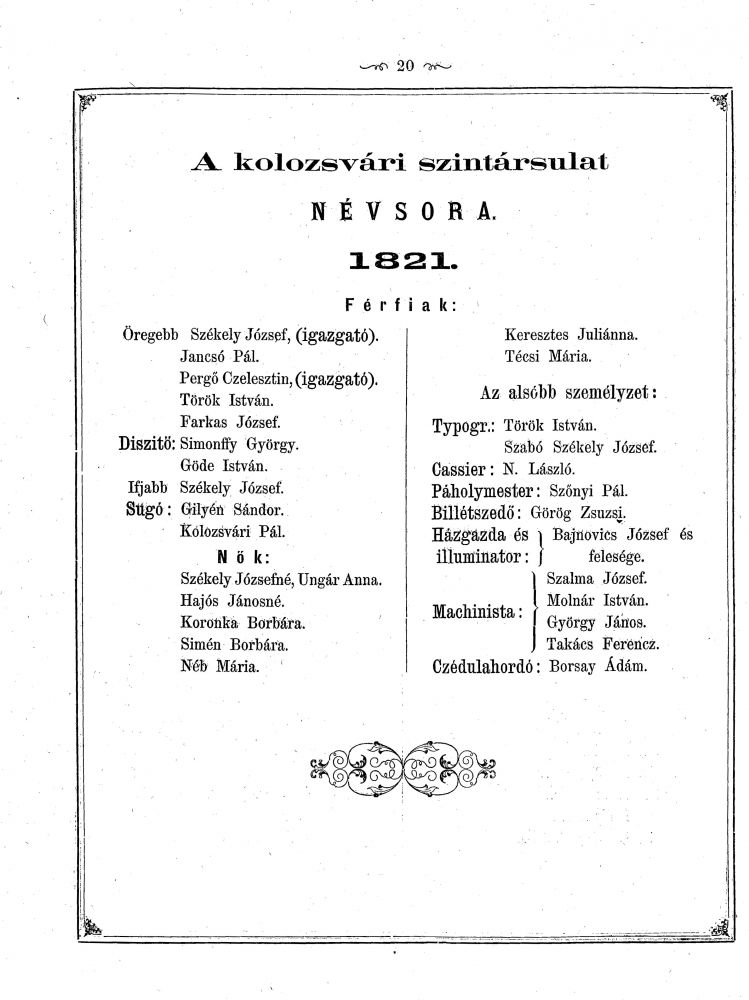
A page of the Memorial Booklet, printed for the 50th anniversary of the Farkas / Kogălniceanu Street Theatre’s inauguration
The First Defining Director on Farkas/Kogălniceanu Street
Shortly after the opening of the Farkas/Kogălniceanu Street Theatre, Lázár Káli Nagy, the chief judge of Cluj, won the right to manage the theatre, who actually organized the construction of the theatre from 1811, and also supported the efforts by donating 1,000 forint. From his book about theatre,[3] we learned what the building was like, inside and out, based on his detailed description. In 1821, Káli Nagy rehired János Kótsi Patkó as a director, who left the company after 1808. Lázár Káli Nagy also hired József Ruzitska, who is considered to be the composer of the first Hungarian opera. Ruzitska then wrote Béla futása (Béla's Run).
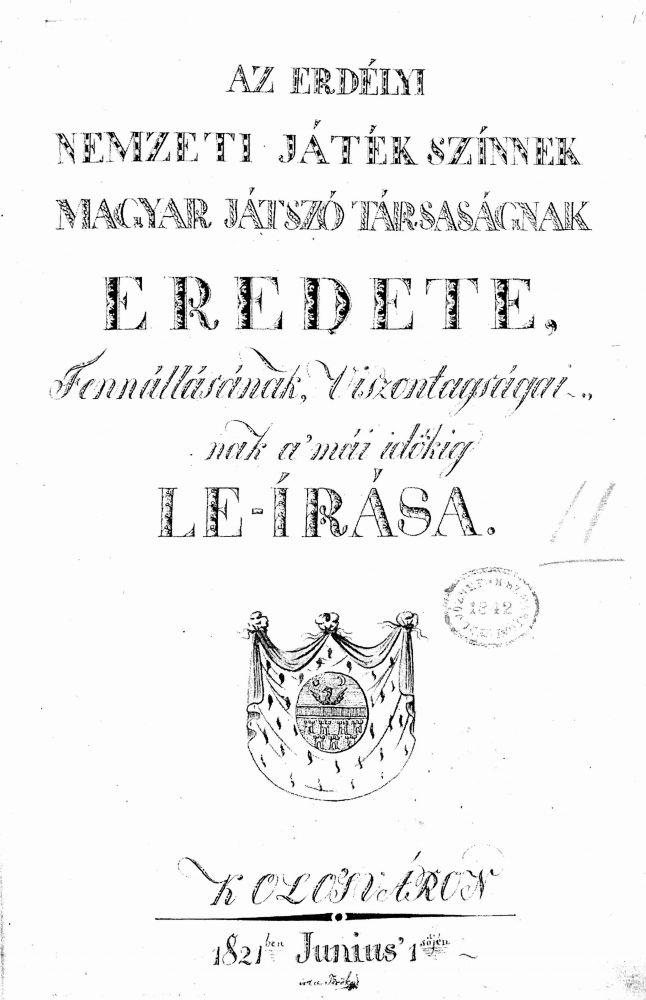
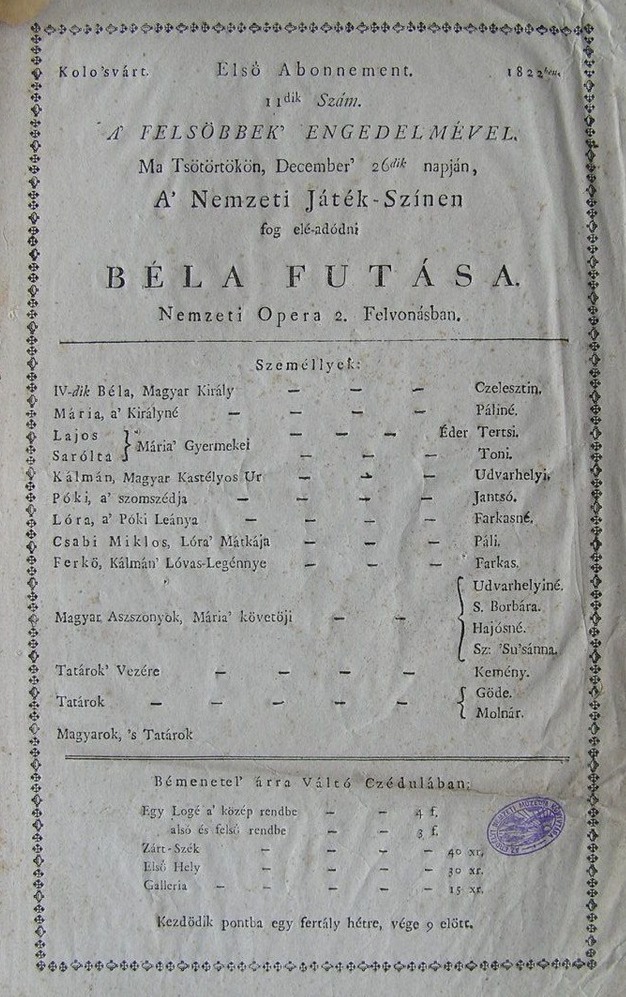
The cover of Lázár Káli Nagy 's book The poster of the first Hungarian opera, from 1822
János Kótsi Patkó (1763–1842)
He was the first particularly talented, educated and versatile man of the theatre in the history of the Cluj theatre. He wrote prose and musical pieces, translated important plays, and was a director, company leader, and theatre historian. His most important roles include Hamlet, Othello or Codrus. Incidentally, he uttered the first word on stage at the opening of the National Theatre on December 16, 1792, just as one of his disciples, István Göde, who deeply admired him, proudly described himself as having had the similar honor at the opening performance of the Farkas/Kogălniceanu Street building, after months of transferring the sets from Vienna for the theatre inauguration… Kótsi remained a member of the company until 1824, then turned his back on the theatre for good. He then conducted two studies meant to propose measures for the more efficient management of the theatre.
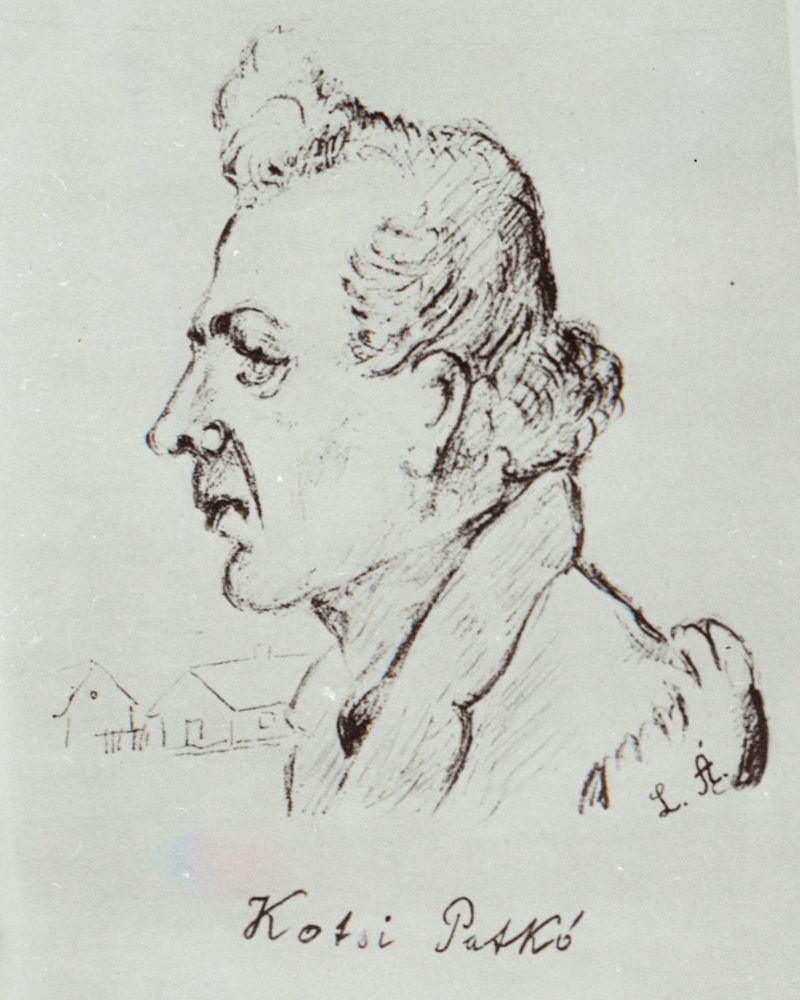
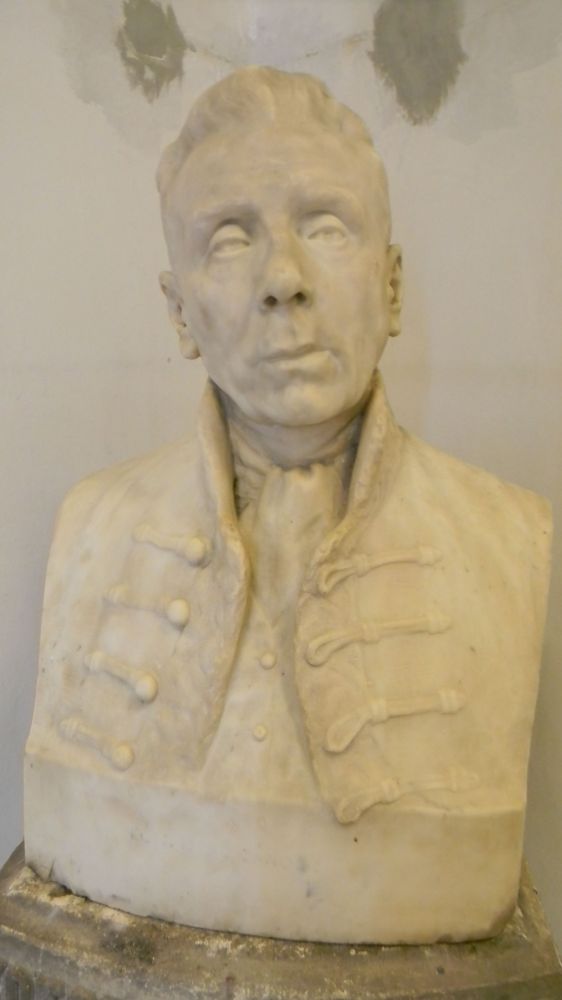
The only drawing left behind of János Kótsi Patkó János Kótsi Patkó. József Róna’s statue commissioned by Jenő Janovics
Pál Jantsó Gidófalvi (1761–1845), the Serious Comedian
When the Wolves/Farkas/Kogălniceanu Street theatre opened, Pál Jantsó Gidófalvi, who was already at an advanced age at the time, was a senior leading actor of the company. His name was there 29 years earlier among the applicant youngsters and had since remained a member of the Cluj National Theatre Group.
Jancsó was an interesting figure of the company. He had a serious demeanor and a beautiful tenor voice, but a very amusing appearance. His long, tall standing physique was only accentuated by his inescapable top hat. Tiny eyes flashed from under his bushy eyebrows next to his hooked nose. He wanted to play heroes and romantic interests, but his appearance always drew laughter from the audience. He played comic roles with the utmost seriousness. He was the first true comedian in the history of the theatre, though the laughter that his acting, or rather his figure provoked was painful for him. This contrast was hard for him to bear, it became a grumpy, grim misanthrope. Pál Jantsó felt that everyone misunderstood him, not appreciating him on his merits. He felt ill-fated, abandoned. Legend has it that one evening, when the enthusiastic audience thanked him for his portrayal with a laurel wreath, he trampled it with his feet in anger and shouted beside himself to the laughing audience, “Oh, but yesterday, when I was playing a proud, smart man, you whistled. Now, when I play an unimportant jackass, you applaud. The audience could be smarter than that!”[4] But his outbursts were overlooked, as he continued to act at the Farkas/Kogălniceanu Street Theatre for another 15 years as a respected actor, highly cherished by the audience. He died at the age of 83. At the Házsongárd cemetery, his collegue, Pergő Celesztin, rests in a grave next to him.
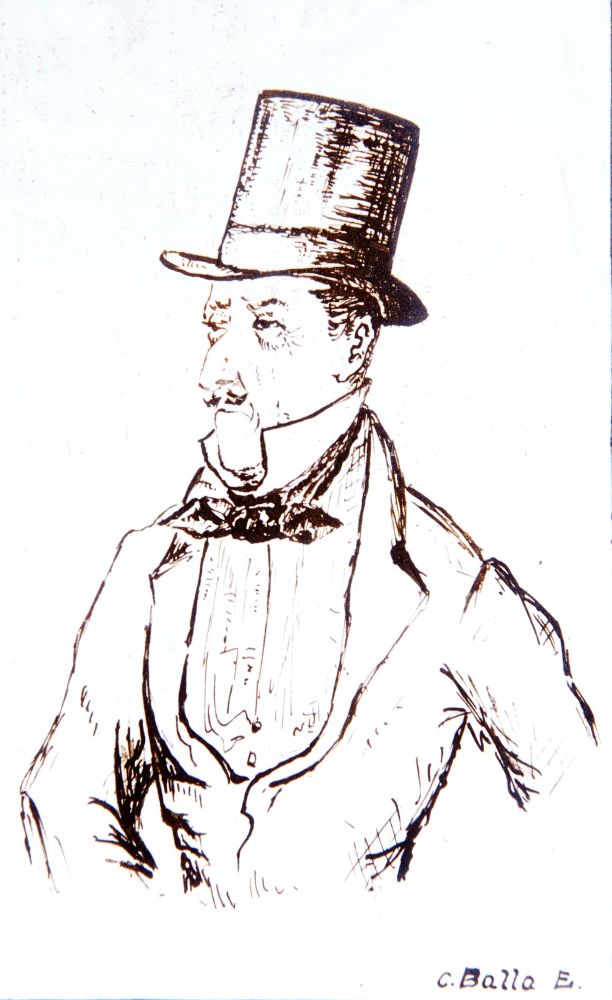
Pál Gidófalvi Jantsó
Pergő Celesztin (1784–1858)
In 1810 he became an actor in Cluj. His hiring in Cluj is legendary: he allegedly played the role he had received on the same morning without rehearsal, jumping in... he later got hired. He was a cultured, handsome man, with a beautiful voice. Passion personified. His restless nature did not allow him to act on one place. He worked as an actor, director and theatre director at several companies. He managed the Farkas/Kogălniceanu Street Theatre on several occasions. He was not liked by his colleagues. His insidious, shifty character was hardly tolerated. Still, his dedicated work and devoted love of theatre has made him one of the most important figures in the history of the theatre.
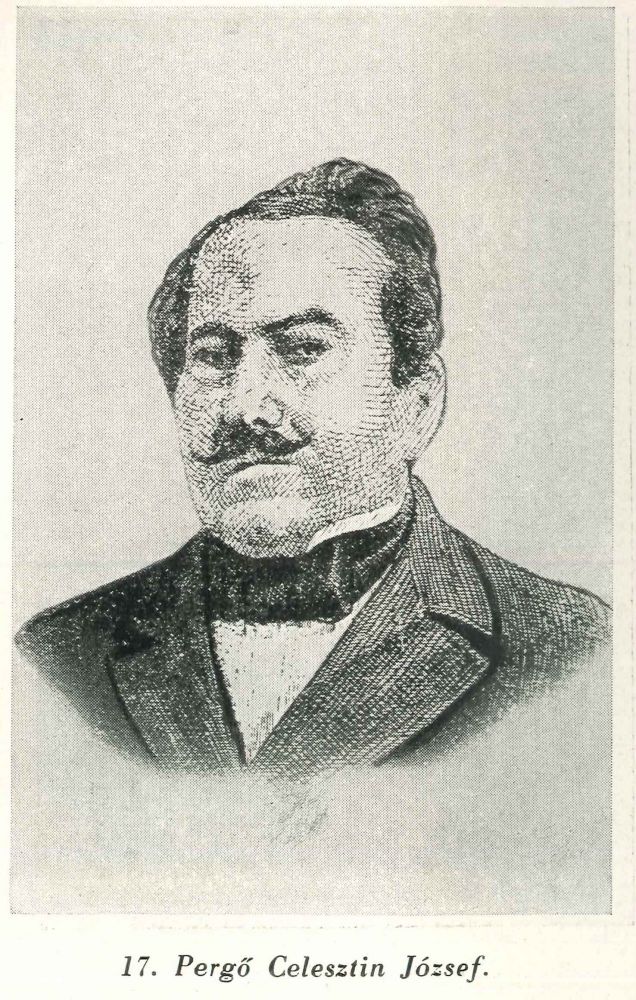
The Continuator of Kótsi's Art, József Székely (? —1831)
József Székely was also one of the most significant members of the Farkas/Kogălniceanu Street Theatre Company. In 1802, Kótsi invited him to the theatre and he soon became one of the most reliable, most precise, and most demanding members of the company. He played heroic and tragic roles with high artistic sophistication, being the heir to Kótsi’s roles. He was also smart and tactful as a theatre director and manager. In key situations, such as alluring Déryné to join the Cluj company, or securing the safe transport of sets made in Vienna to Cluj for the opening of the Farkas/Kogălniceanu Street Theatre, it was him whom the company entrusted with these tasks, taking into account his reliable nature and highly skilled diplomacy.
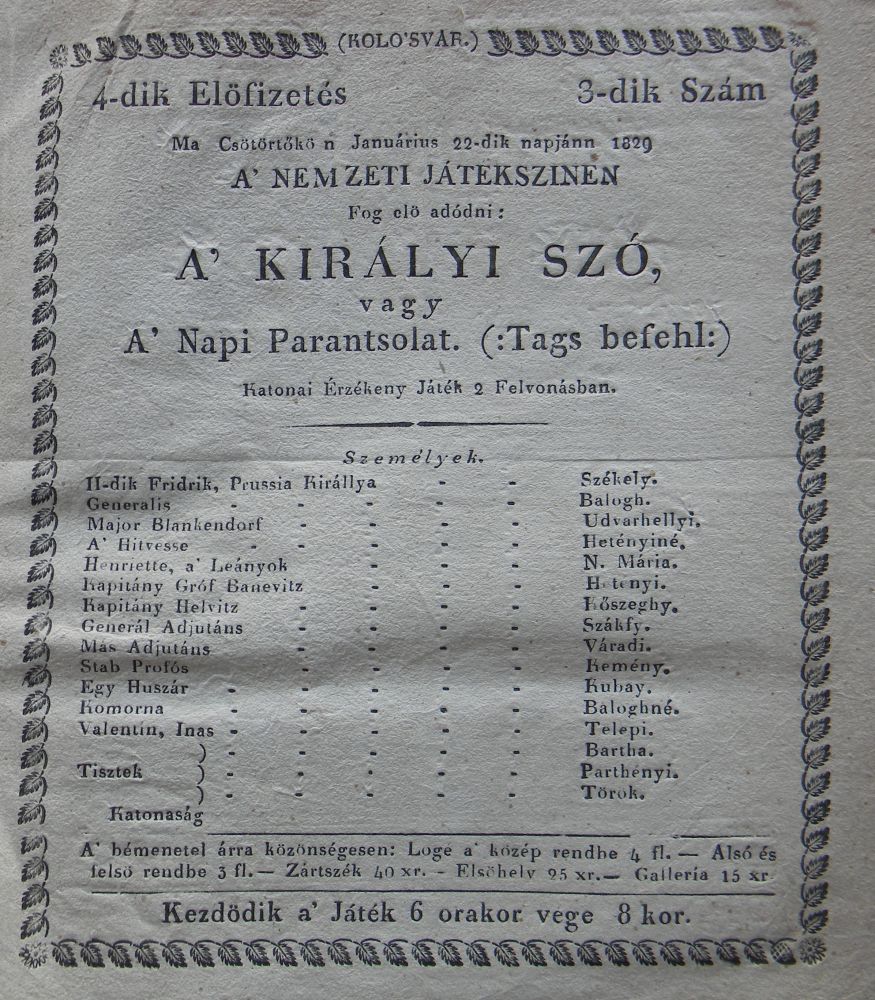
Contemporary poster featuring the rol of József Székely
Two Notable Actresses of the Farkas/Kogălniceanu Street Theatre
József Székely's wife, Anikó Ungár (1796–1865), whom Janovics also remembered with great admiration in his book about the Farkas/Kogălniceanu Street Theatre, became an actress at a very young age, joining the theatre at the age of ten. A very sensitive, empathetic personality lied behind her beautiful appearance. She gave her heart and soul to the theatre. This was also the reason for her marriage, as she was not quite 18 years old when the company planned on going on tour to Târgu Mureş for a summer guest performance, and she by no means wanted to miss the trip, however, considering her tender age and the moral constraints of the time, her mother did not allow her to travel alone. Accordingly, Anikó asked her highly esteemed actor colleague, József Székely, to marry her... so she could follow her husband and company on the trip. Her art was appreciated not only in Cluj, but also in Pest and Buda, Miskolc and Bratislava while guest performing, she was one of the most celebrated actresses of the era. In the year of the inauguration of the Farkas/Kogălniceanu Street Theatre, she played Cordelia there, but in 1812, when Macbeth was first staged in Hungarian in Cluj, she was the one who portrayed Lady Macbeth. But she played Juliet and Ophelia, as well. She was repeatedly invited to Buda and Pest, but remained a Cluj actress for the rest of her life. The same thing happened with Mária Néb (1799–1884). She already was a member of the Farkas/Kogălniceanu Street Theatre at the age of 22. She was a Cluj resident through and through, and was lured to the Buda theatre in vain, as she could not part with her city. Her comedic actress talent hid a bitter, aloof, and eccentric personality in real life. On stage, she always appeared as an explosively cheerful, temperamental person.
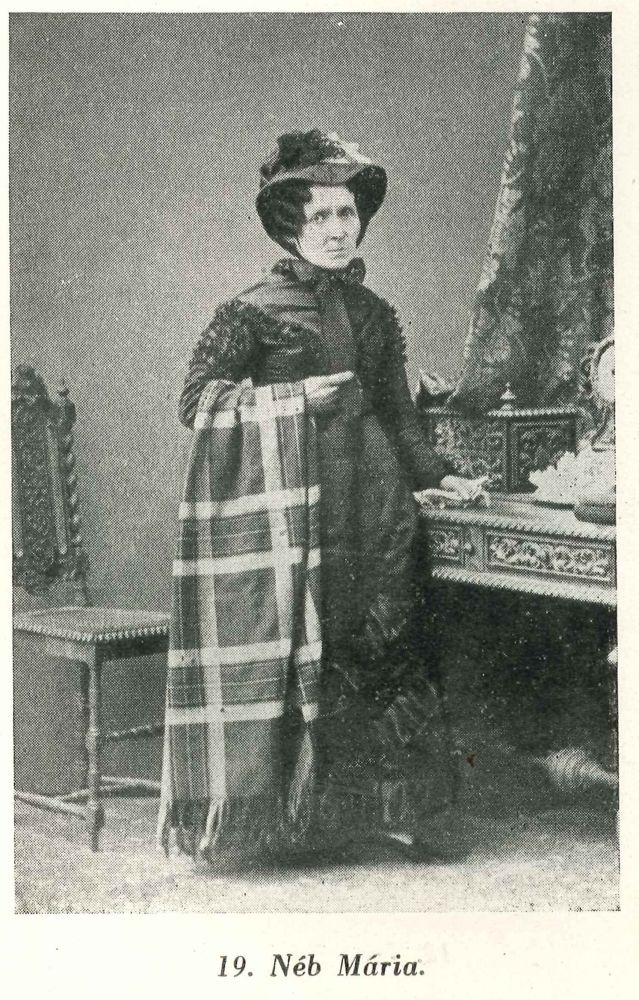
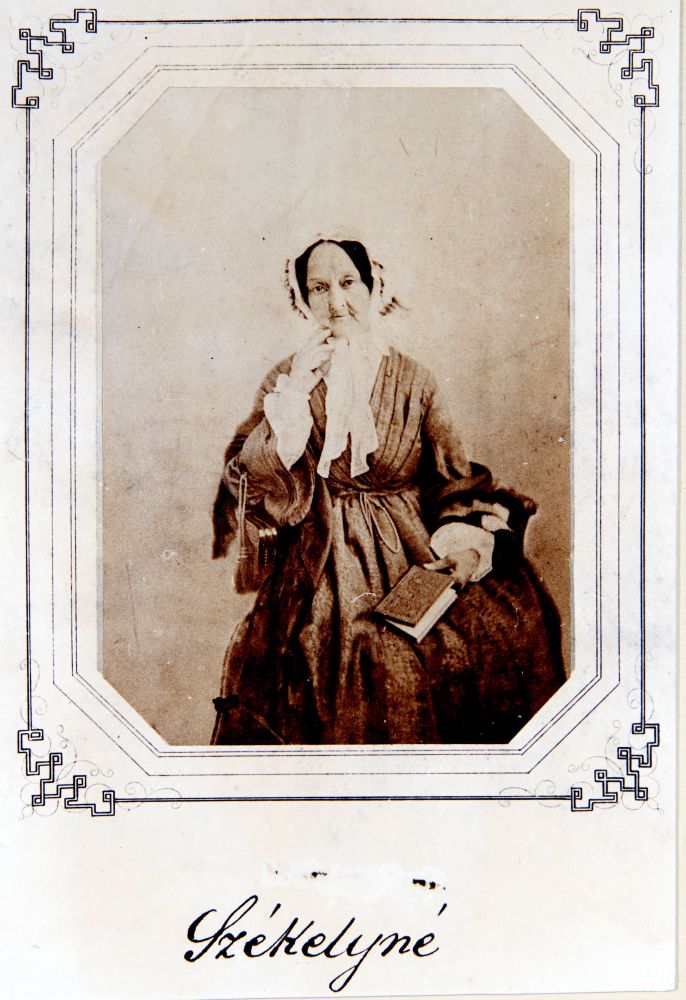
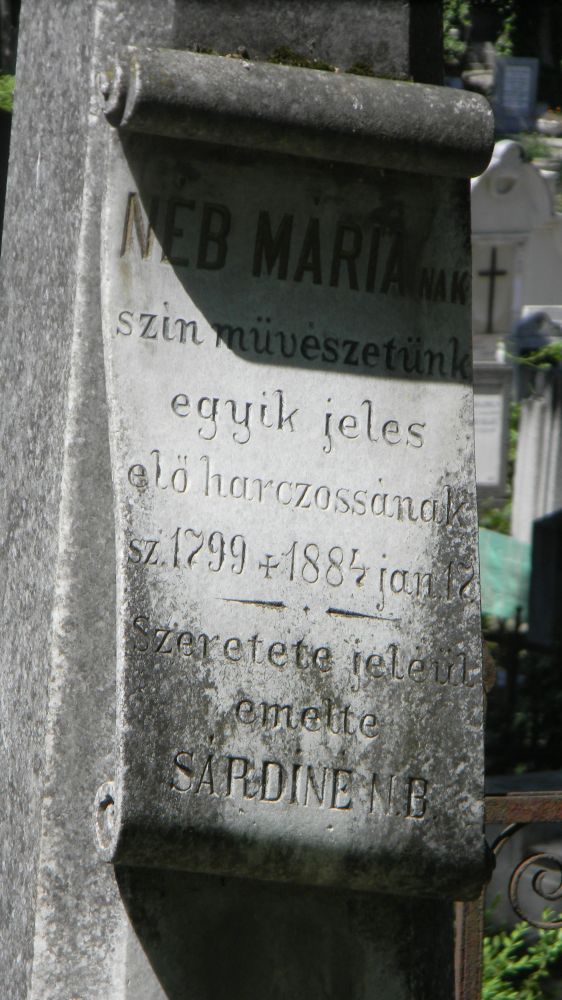
The tomb of Maria Néb from Házsongárd / Cluj Central Cemetery
The first operatic primadonna in Cluj
Déryné Róza Széppataki (1793–1872) was not from Cluj, but she considered Cluj as her second home. She was first persuaded to come to Cluj by Lázár Káli Nagy, when he was the head of the theatre, in 1823. Káli has made great efforts to raise the level of musical performances to the highest possible standard. Déryné Róza Széppataki’s name as a singing actress was widely renowned in Hungary at that time. Her warm, soaring soprano and sophisticated acting style made her uniquely special. She performed in all the theatres of the country, they loved her everywhere. She had her reservations about Cluj, but when József Székely and Miklós Udvarhelyi managed to lure her away from Miskolc, Déryné Róza Széppataki did not set foot outside of Cluj for four years. She recorded this in his diary regarding one of her performances: “I was overwhelmed by flowers. I could hardly walk on the stage from the many flower bunches people threw on it.”[5] “Such is the people of Cluj. Sensitive, dreamy and straightforward, cordial, kind, sweet tongued (...). ”[6] - she wrote on another occasion. At that time, there were no singers, nor an orchestra or a choir at the Farkas/Kogălniceanu Street Theatre. Déryné’s energetic personality created amazing conditions for them to perform more serious musical pieces. She brought singers from other companies, recruited singers from the music school, and taught them to act herself. She enlisted art lovers for the band: she persuaded distinguished gentlemen, counts, government officials to improve their instrumental skills, and supported the development of conductors. Following Déryné's efforts, the theatre soon became able to play opera in Cluj, and we can rightly say that due to Déryné's actions, Cluj became the creator of Hungarian acting and the cradle of Hungarian opera. Not only was Déryné significant as a singing actress, but she also played dramatic roles with great success. She was, for example, Melinda at the premiere of Bánk bán in Košice in 1833, and then resumed the role at the Cluj premiere, in 1834.
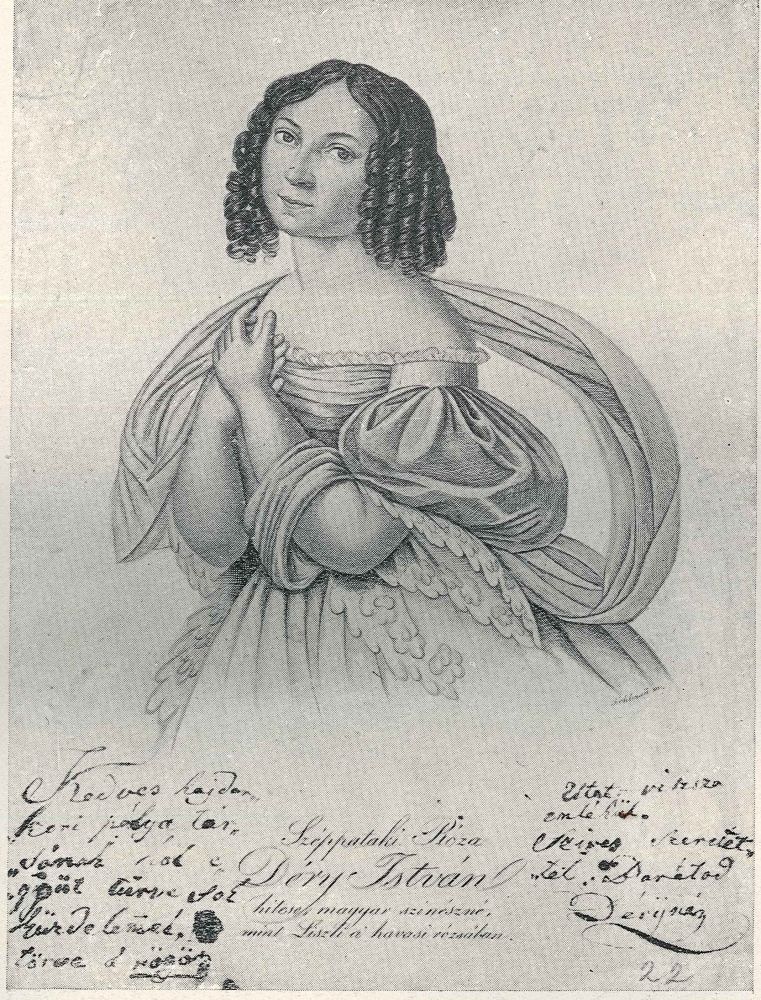
Déryné Róza Széppataki
Jászai and Kassai
Few people know that the career of the great Hungarian tragedy actress Mari Jászai (1850—1926), also started in Cluj. She arrived to Cluj as Vidor Kassai’s (1840—1928) wife, in 1869. Vidor Kassai was a multi-talented man: he was an actor, but also a writer and painter. Kassai was predestined for comedic roles, based on his less than attractive appearance. In this was the stark opposite of Jászai, who was a tragedy actress who had a velvety, low voice and a dignified appearance. In Cluj, Jászai, who started as an auxiliary actress, read every free minute she could. Kassai’s bookcase was all the furnishing they owned. Reading and her thirst for knowledge distracted her from the fact that she was always hungry because she could only afford one meal a day. “I was already playing my first roles when I used to pick up the cheese and bread crusts off the street, skewer them at home with a needle, burning around it, and eating it. Kassai, my husband, used to go to the café to have breakfast and a snack, coffee and eggs. ” she writes in her memoirs.[7] If we examine the contemporary posters, we can see that Mari Kassainé Jászai first got a bigger role on April 22, 1869, playing Deborah in Mosenthal's drama with the same title. The same year she performed another 25 performances, playing 25 different roles according to the custom of that age, then the following year the performed 81 times, then 65 times in the year after that, and finally in 1872, until mid-March, before being invited to the Pest National Theatre, she portrayed no fewer than 27 roles, on 27 distinct nights, in 27 different productions. At the early stages of her career, she already played mostly tragic heroines or dignified grandmother roles, playing queens, princesses, marquise, tsarinas, ladies, or beggars, desperate mothers. Her iconic role was Gertrudis, which she first portrayed in Cluj, in November 1871, and later resumed the role frequently during her frequent guest performances in Cluj. She was also invited to play Gertrudis by Janovics in the farewell performance marking the closing of the theatre building on Farkas/Kogălniceanu Street (1906), and in Janovics’ film Bánk bán (1914, director: Mihály Kertész), where she also portrayed the Queen.
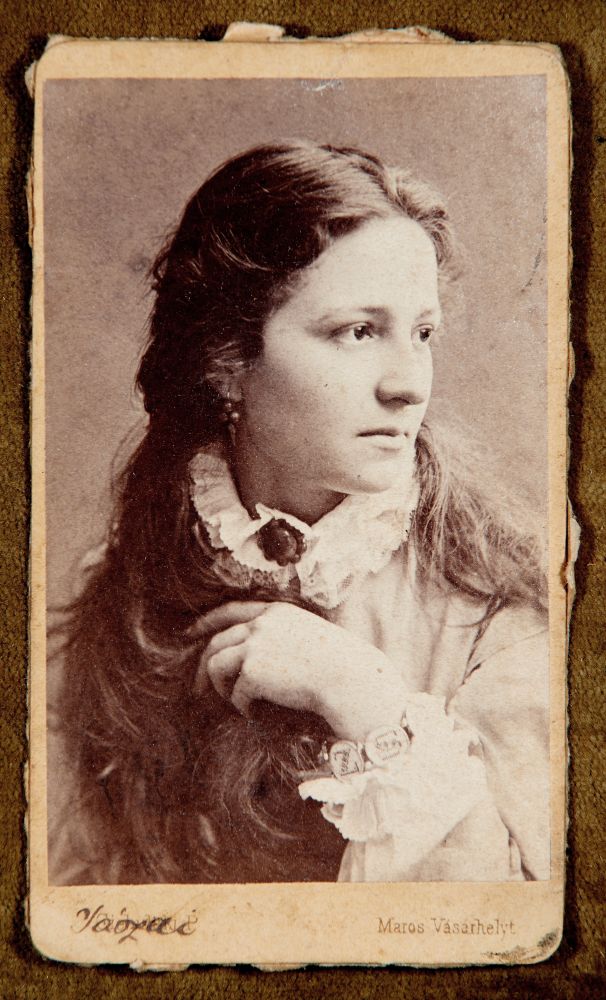
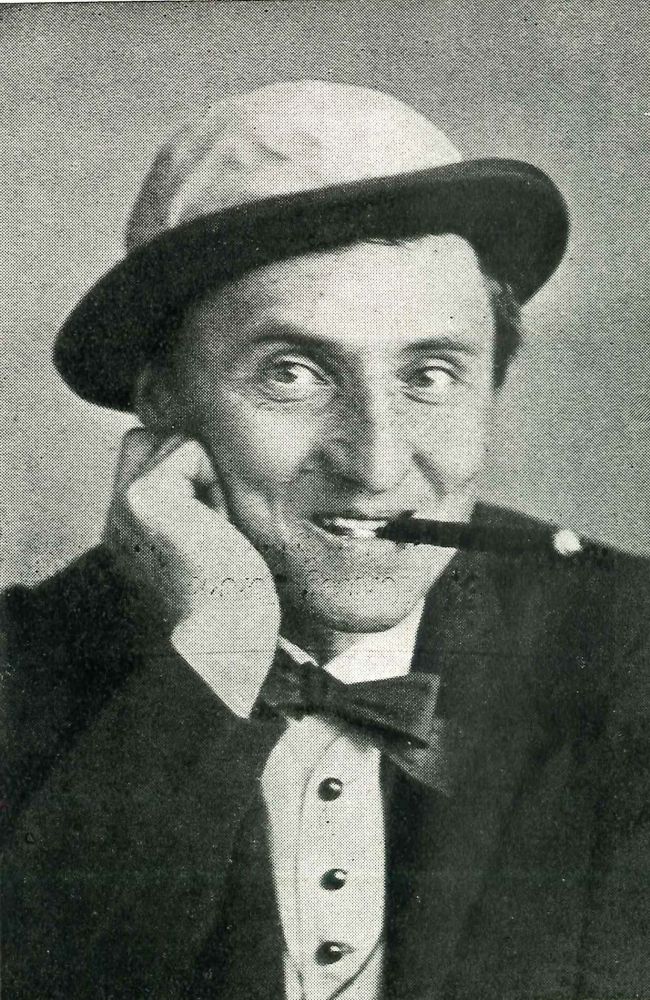
The young Mari Jászai Vidor Kassai
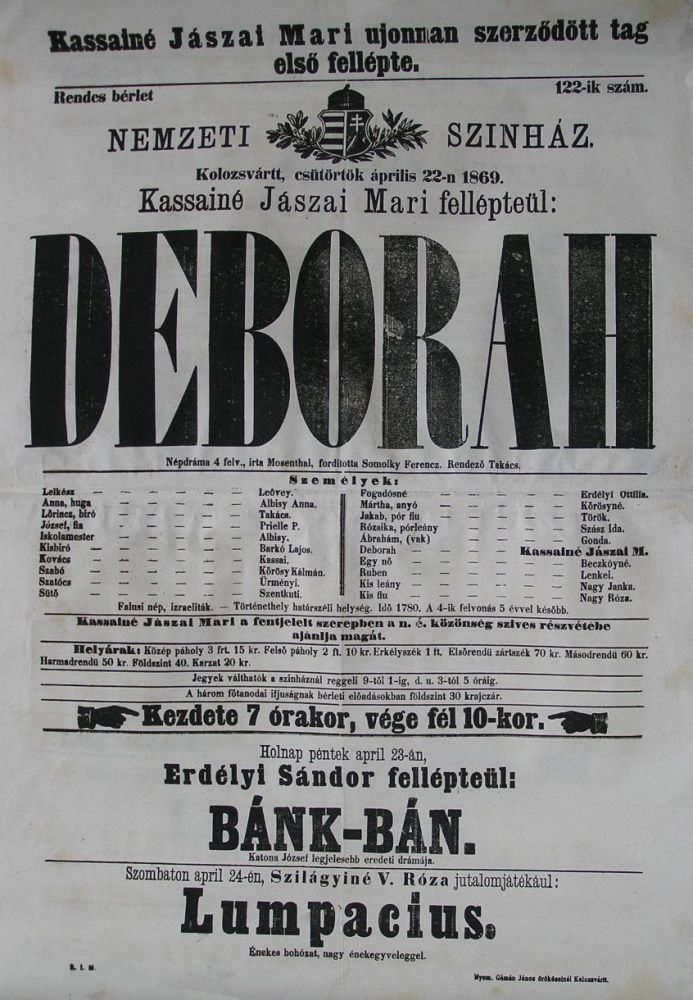
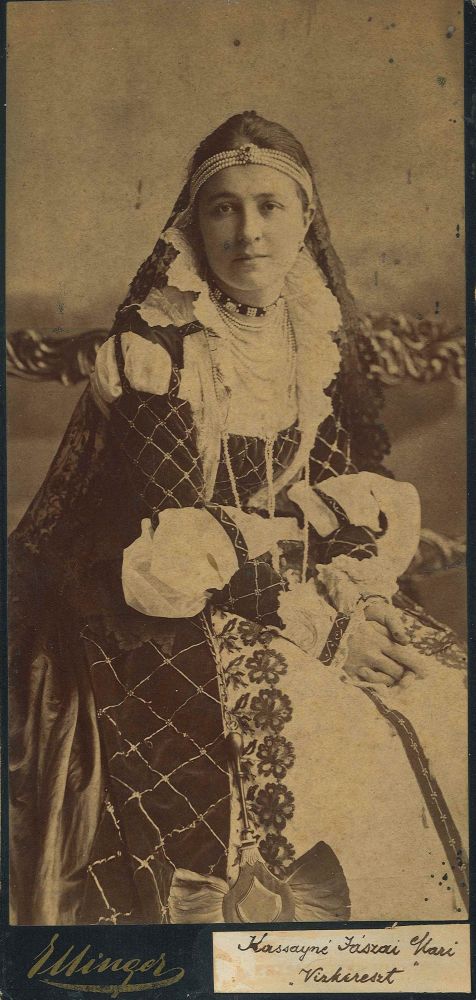
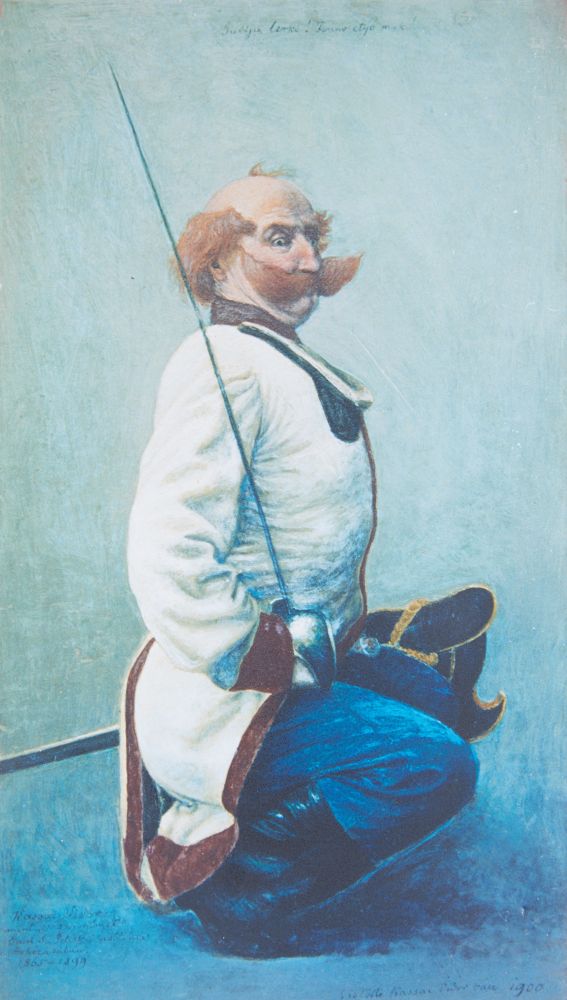
Mari Jászai’s first role in Cluj Mari Jászai in Cluj Self-portrait of Vidor Kassai as Peleskei, the Notary
Leading actor and director
Gyula Ecsedi Kovács (1839–1899) moved to Cluj in 1865, after having had worked as an actor in Debrecen and Pest, and remained a Cluj actor until his death. In terms of his build, voice, and acting style, it was as if he had been created for the Farkas/Kogălniceanu Street Theatre, which has always been seen as a temple of profound national and serious artistic efforts. He was the most authentic leading figure of the golden age of the Hungarian theatre, being classically well built, having an impressive appearance, but an extremely sensitive, sophisticated, gentle voice and manner of speech. His acting, as well as his personality, were always driven by the deepest sense of patriotism. As an actor, he was a worthy follower of the style of acting set forth by Zsigmond Szentpéteri, Gábor Egressy and Márton Lendvay. He was not only a leading actor of the Farkas/Kogălniceanu Street Theatre, but also worked as a director and artistic director. As a director, he staged Petőfi's highly acclaimed Tiger and Hyena as a national premiere. His death also occurred while praising Petőfi: on the plain in Fehéregyház, where Petőfi dies, he was reciting a poem on the 50th anniversary of the poet’s death, and struck by the heat of the sun, he fell over, and subsequently died. Cluj was in deep mourning. Hundreds gathered in the courtyard of the Farkas/Kogălniceanu Street Theatre to say goodbye to him. His beloved colleague, István Szentgyörgyi, with whom they served Thalia on countless evenings, and with whom they shared a close friendship based on mutual respect and admiration, said goodbye to him in the following manner: “Bánk bán! Great lord! Your faithful Tiborc bids farewell to you!”
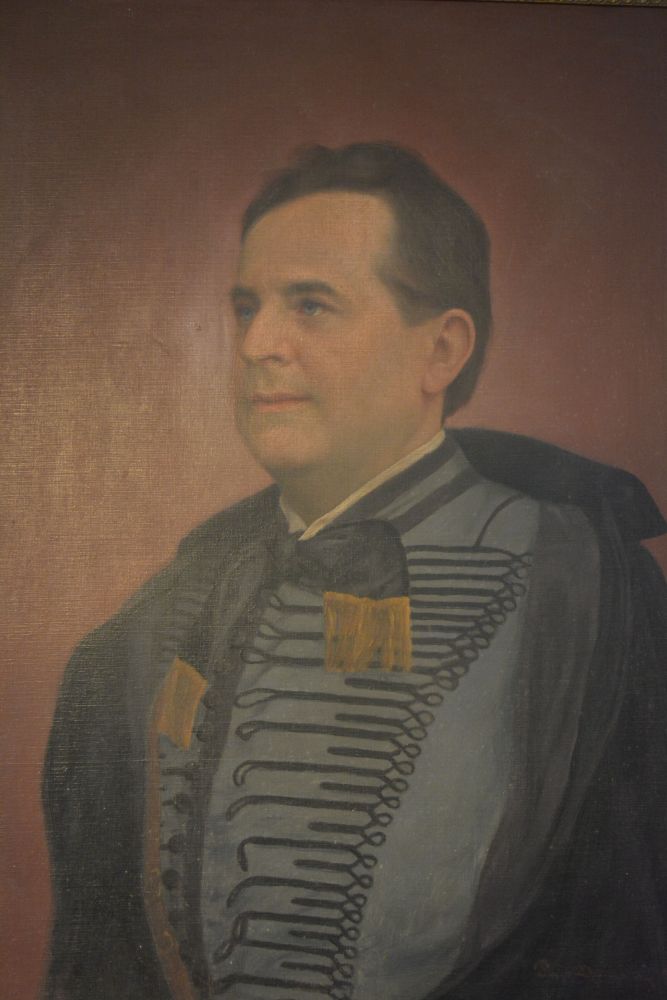
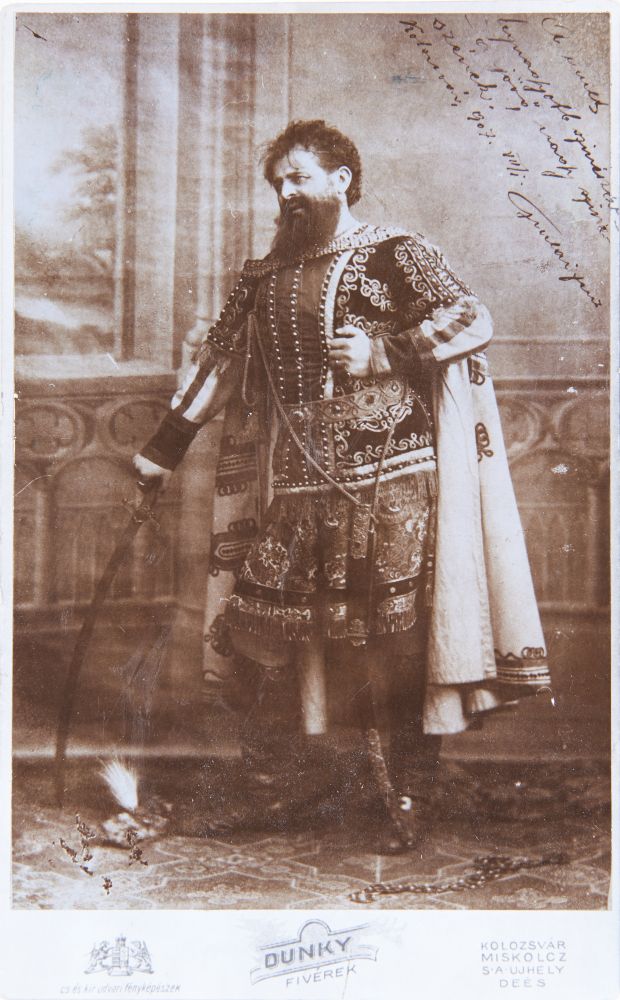
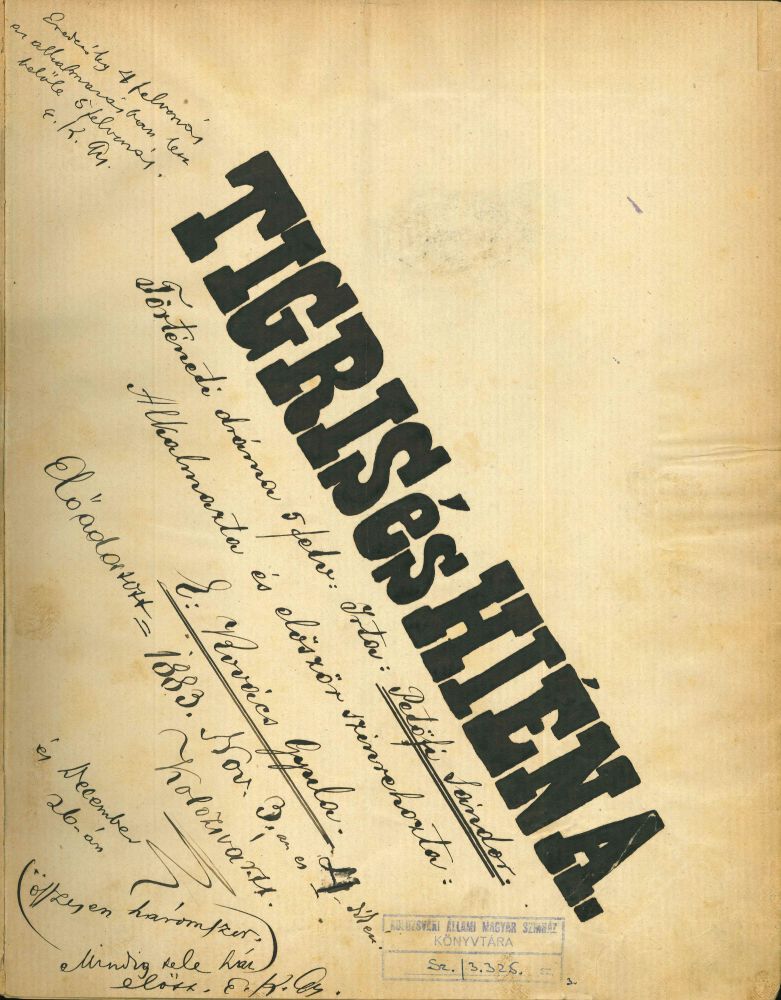
Gyula E. Kovács Gyula E. Kovács as Bánk bán Tiger and hyena - director's script
The Eternal Tiborc
Similarly to Gyula E. Kovács, István Szentgyörgyi (1842—1931) studied in Debrecen, then after a ten-year detour, he joined the Hungarian theatre company in Cluj, in 1871, where he remained for the rest of his life, just like E. Kovács. They played on stage together for decades, almost every evening, yet lived in two separate worlds. E. Kovács lived with his head in the clouds, while Szentgyörgyi stood firmly on the ground, with both feet planted. He was temperamental, outspoken, direct. “He was a man, without trimmings and frills, without useless mannerisms, and one saw that in his movements, in his voice, in his gestures, in his walk, in the sparkle of his eyes. His artistic tools were consummately simple and that is why they were so puritanically noble. He didn’t play, he lived on stage.” - wrote Jenő Janovics about him.[8] His iconic roles included Zsiga the Gypsy, Csikós, Tiborc, the Peleskei notary, Vén bakancsos, the Corporal Peták in Piros bugyelláris, Professor Szilvay in the Liliomfi, Pusztabíró in Sárga csikó. He was an actor for 70 years, of which he spent sixty in Cluj. He had a garden on Dónát Street, where he hoed, mowed, and cared for his fruit trees when he could. He left us at the age of 90, quietly, without fuss. Jenő Janovics managed to fight to declare him the honorific member of the Cluj Theatre.
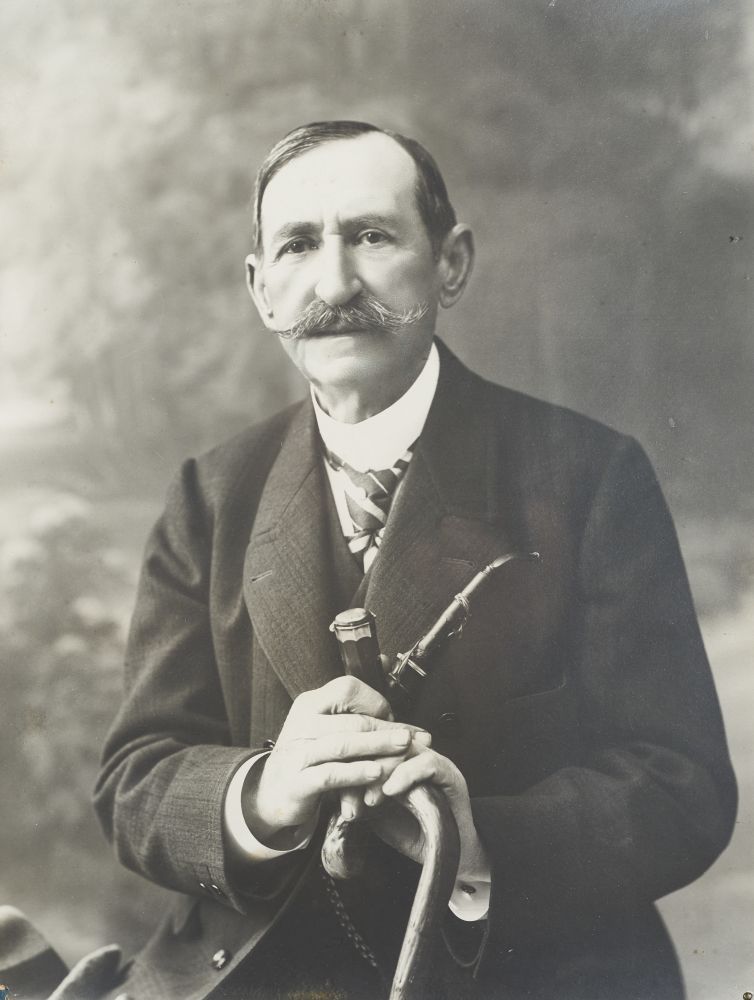
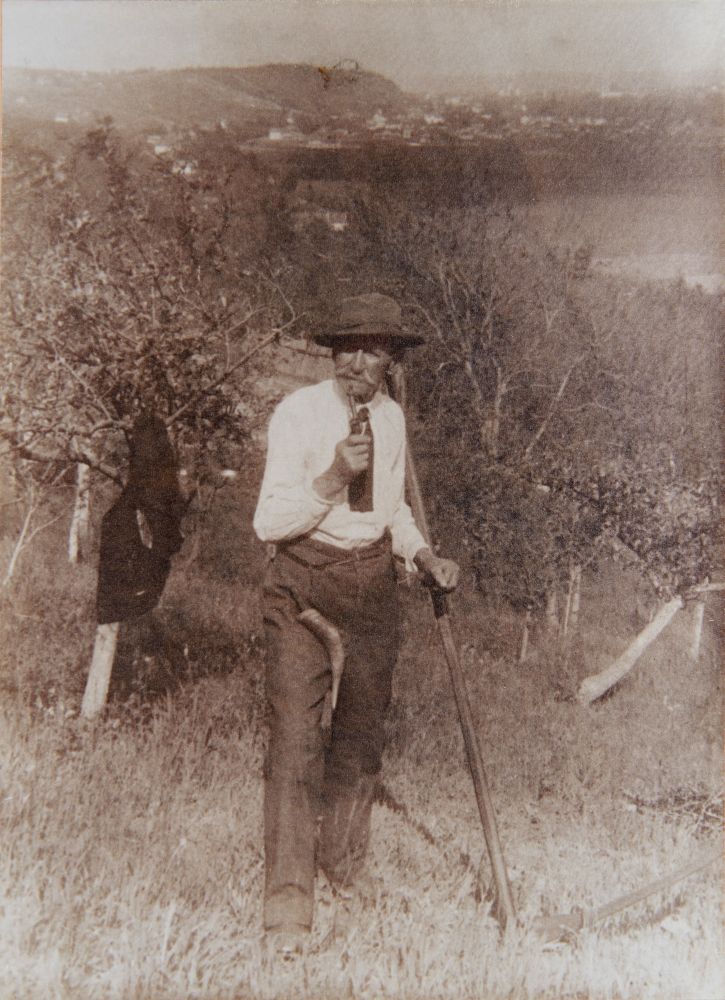
István Szentgyörgyi Szentgyörgyi in his beloved garden
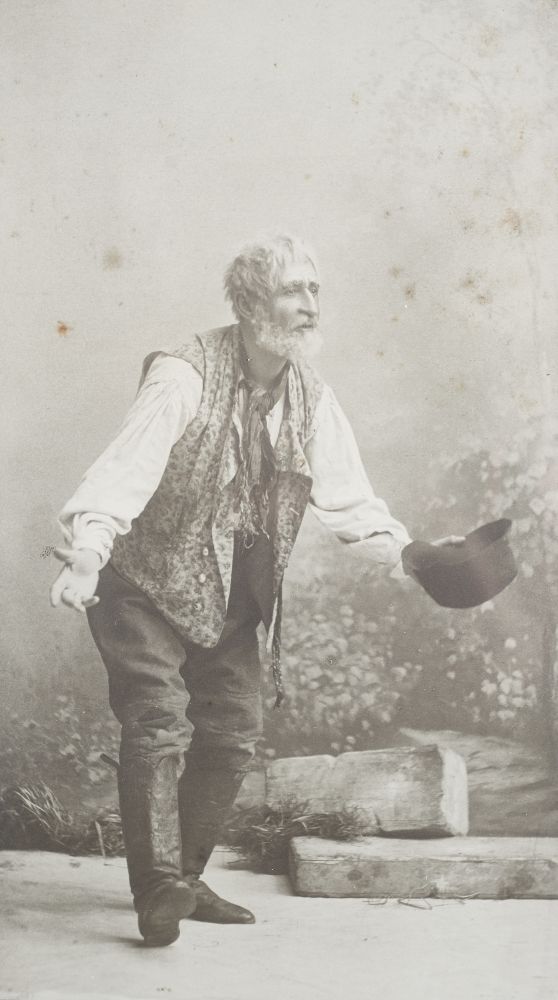
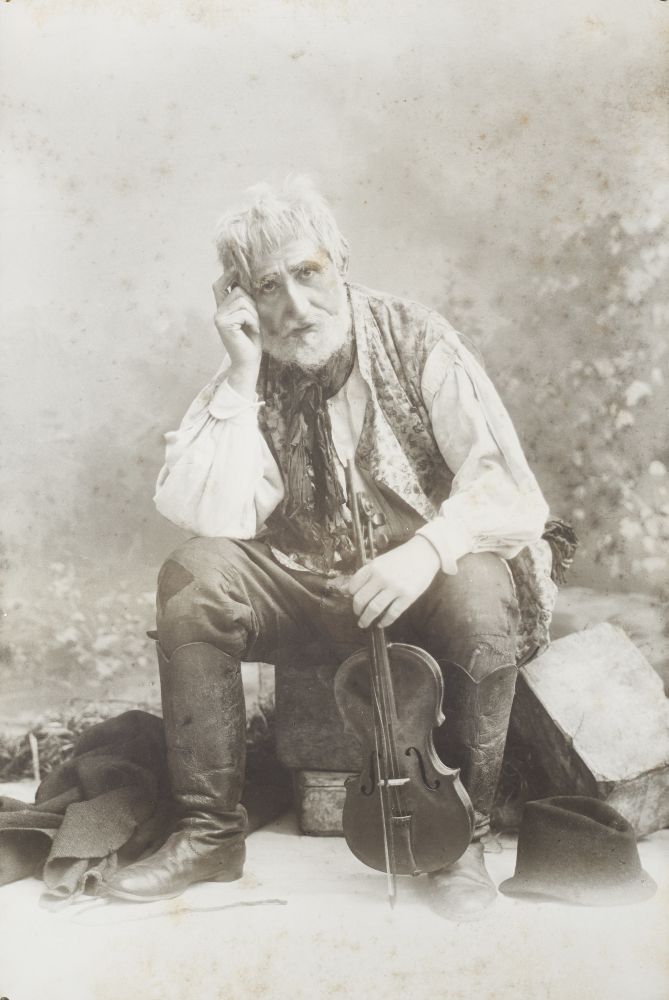
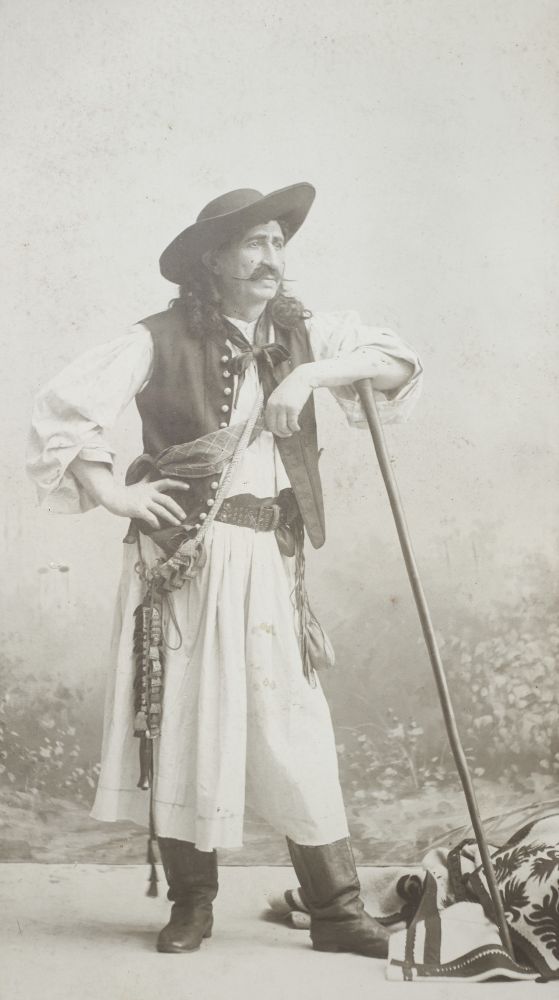
The Director of the National Theatre of Cluj and the Comedy Theatre of Budapest
Mór Ditrói (1851–1945) became an actor in Cluj, in 1874, and then toured the entire country. He was invited by the intendant József Bölöny as artistic director in 1887. During his barely 9 years of administration, Ditrói proved that he was worthy of the faith entrusted in him. His infallible artistic exigency, was match only by his unwavering will. He discovered new talents with wise precision and launched their artistic careers. In his Cluj years, his performance cycles became memorable: the Hungarian cycle in 1891, which lasted for 48 days, and showcased 56 productions created by 42 Hungarian writers and composers, followed by a Shakespeare cycle in 1894-95 with 17 Shakespearean premieres. In 1896, in the light of his tenure in Cluj, he was asked to found the Budapest Comedy Theatre, where he took with him most of the members of the Cluj company, including Gyula Hegedűs, Sándor Góth, Gyula Gál, Zoltán Szerémy, Oszkár Beregi, Emma Delli, Margit Hunyady and her husband, Árpád Szathmáry. Ditrói successfully ran the newly established theatre in Budapest for twenty years, (re)creating there the acting style he considered to be ideal: the frills-free, coordinated artistic endeavor based on experience and honesty. In the Comedy Theatre, as in Cluj before that, he personally looked after the staging of each and every play, despite the fact that no traces could be found of this on the contemporary posters.
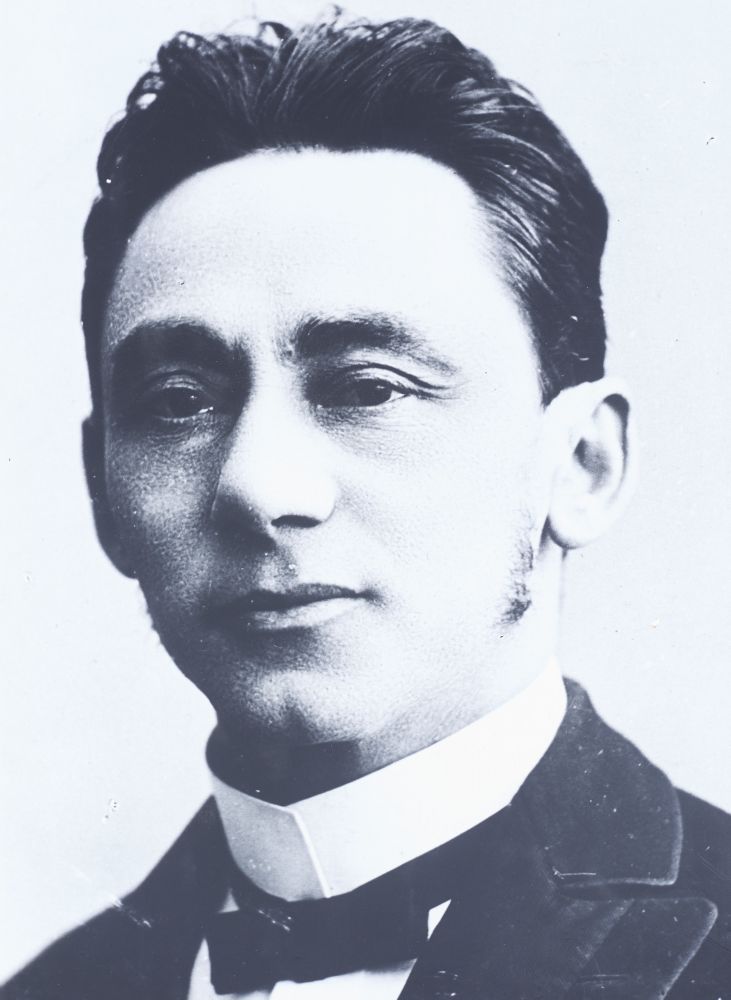
Mór Ditrói
The Last Director of the Farkas/Kogălniceanu Street Theatre
From 1905 onward, Jenő Janovics (1872–1945) continued in the leadership style, approach to company building, and repertoire enhancement that Ditrói set forth. That was the year when Janovics won the competition for director of the Cluj Theatre. It was then that he signed a contract with the Cluj company for the second time, since he first became an actor with the Farkas/Kogălniceanu Street Theatre Company in 1896, two years after graduating from the Academy of Actors.
A year later, he was regularly given directing tasks, and then intendant József Bölöny entrusted him with the artistic management of the theatre. Janovics was the artistic director of the company for a year, between 1900-1901. Then he left Cluj for 3 years, became the theatre director in Szeged, then came back to Cluj in 1905, when he had already been appointed as a director. One of his most important tasks was to complete and begin the activities in the new theatre building on Ştefan cel Mare Square.[9] Although during his years at the Farkas/Kogălniceanu Street Theatre, Janovics was only at the beginning of his rising career, even then he showed promise of his versatile theatrical and film talent. Among other things, as early as 1899, he staged Blumenthal-Kadelburg's film Moving Photographs in which he incorporated cinematic sketches, i.e. film scenes. In 1906, the theatre building in Ştefan cel Mare Square was inaugurated and they bid farewell to the obsolete, old theatre building on Farkas/Kogălniceanu Street. Even before the summer season, which was regularly showcased on the stage next to the Someş River, the Színkör, in June 1906 a festive performance of Bánk bán was organized in the old building, where Mari Jászai performed. Janovics considered József Katona's drama to be the most worthy play for the farewell performance. Then in early September, at the start of the winter season, life began in the new theatre. When creating the ceremony, Janovics wanted to give a nod to the inauguration festivities of the Farkas/Kogălniceanu Street building, which also lasted for two evenings, so on September 7, the first night, there was one last performance at the old Farkas/Kogălniceanu Street Theatre, Janovics putting together the program by reviving several numbers from the 1821 inauguration program.[10] The next day, on the 8th, the highlight of the evening was the piece written by Ferenc Herczeg, entitled Színházavatás (Theatre Inauguration).[11] The theme of the Theatre Inauguration once again pays tribute to Janovics' respect for the theatre's historical past, as the scene depicts a director, who looks at the final touches of the new theatre building, delves into the past and a scene appears in his mind’s eye of the opening ceremony of the Farkas/Kogălniceanu Street Theatre, attended by such notable personalities of the theatre, as: Márton Lendvay, Gábor Egressy, Zsigmond Szentpétery, József Szerdahelyi, János Kótsi Patkó, Pál Jantsó, Celesztin Pergő, Lajos Fáncsy, Anna Kántor Engelhardt, Déryné Széppataki Róza, Rozália Kótsiné Fejér, and Róza Jókainé Laborfalni. In the vision, understandably, the time planes merge, but each of these characters had somehow been connected to the Farkas/Kogălniceanu Street Theatre.
On September 7, 1906, the old theatre building was finally closed. In 1919, when the Hungarian company had to hand over the theatre building in Ştefan cel Mare Square to the Romanian company, Janovics had the idea to renovate the old building so they can move in, but the new regime refused the idea. Thus the orphaned building stood tall until 1935, when it was demolished and Casa Universitarilor was subsequently built above and around it.
A memorial plaque made for the 200th anniversary of the Hungarian theatre in Cluj was placed on the wall of this building by posterity’s representatives.
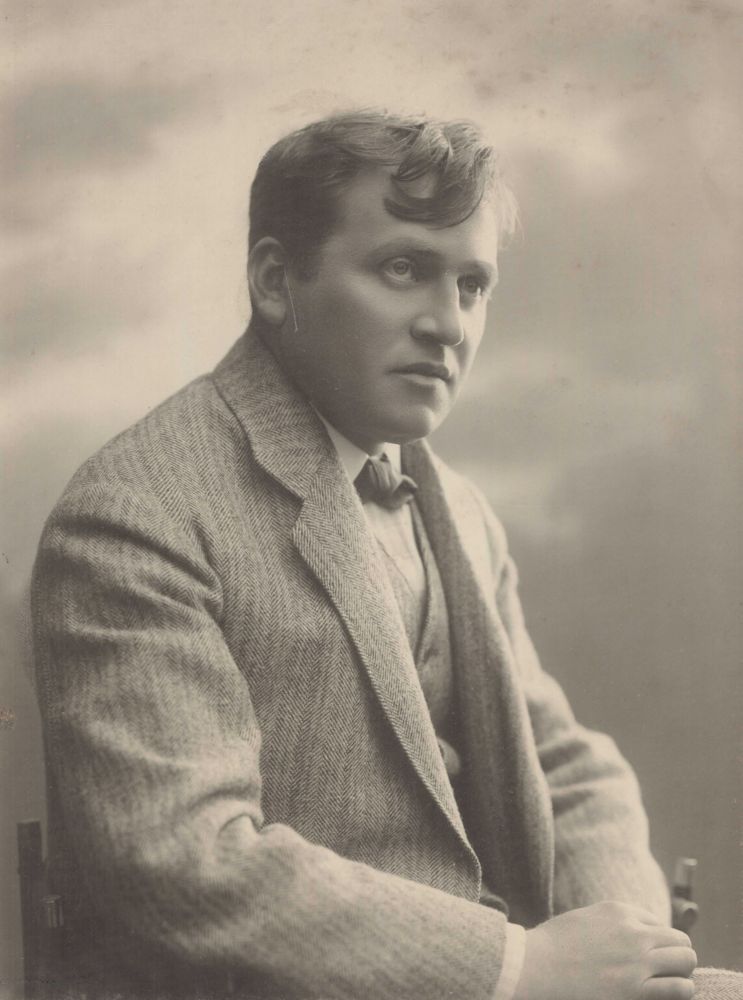
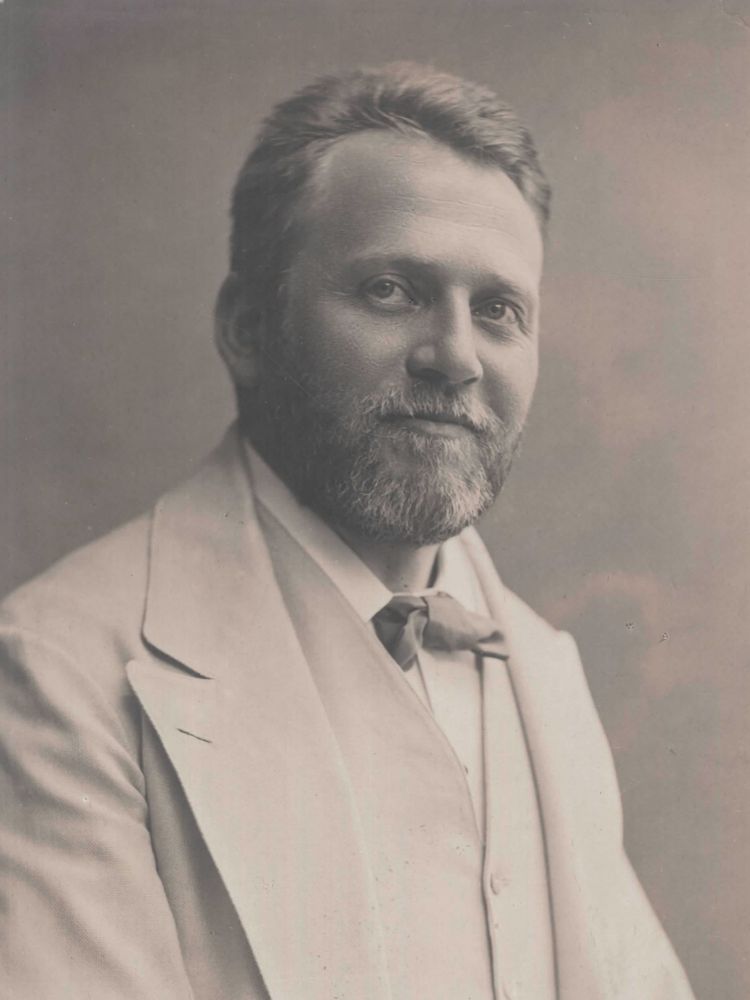
Jenő Janovics Jenő Janovics
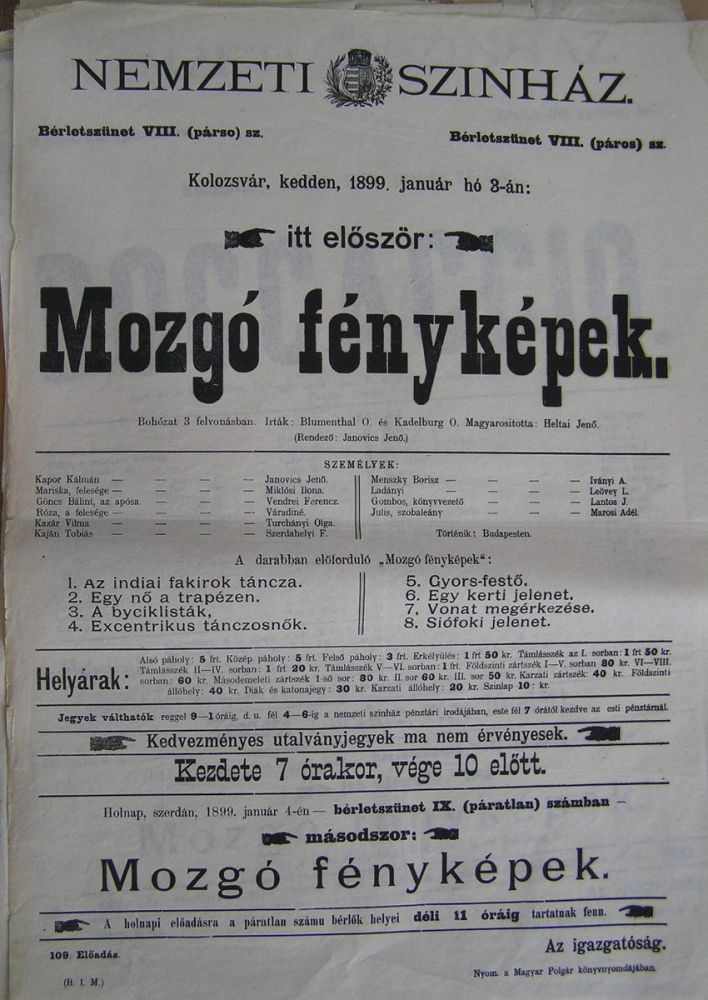
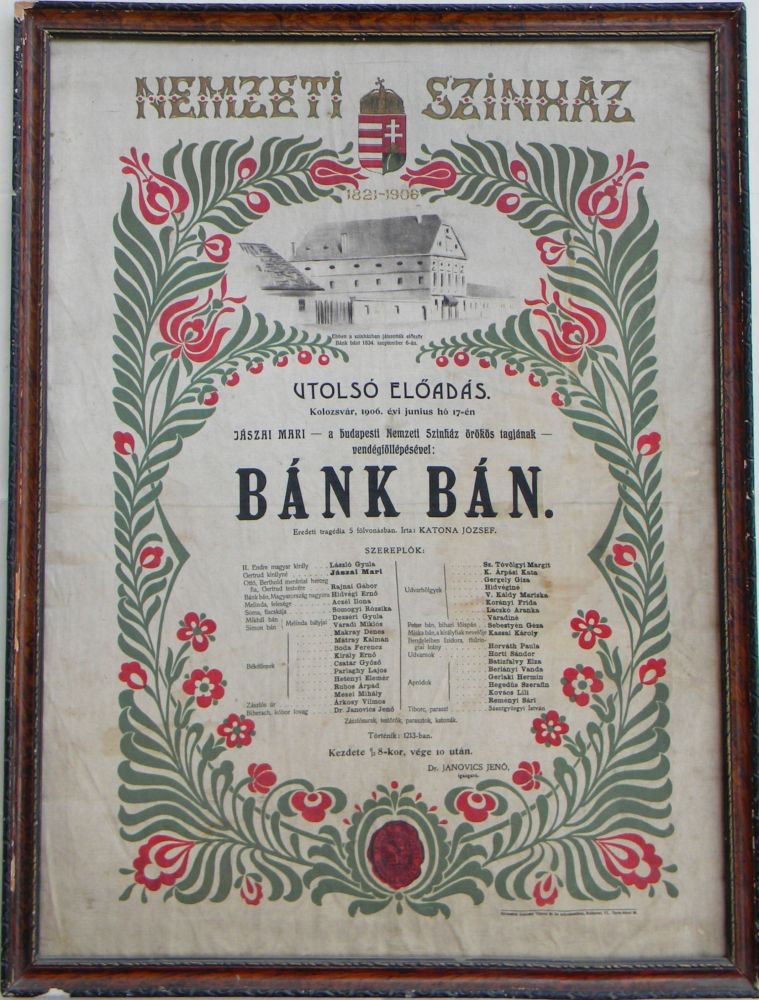
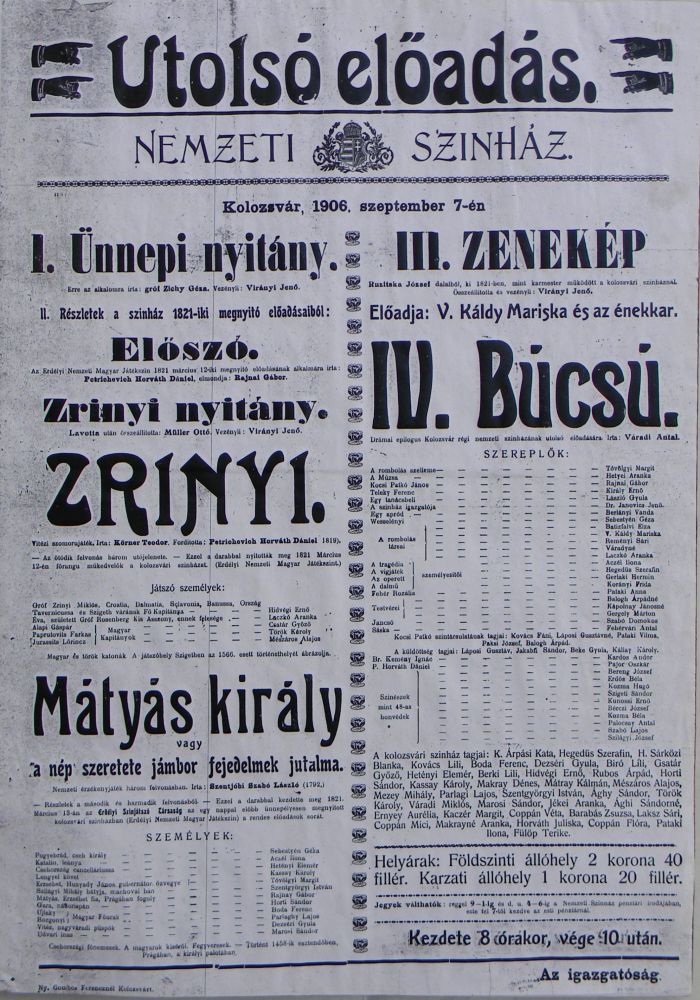
Film on the Cluj stage, in 1899 Festive performance poster The last performance presented at the Farkas / Kogălniceanu
Street Theatre
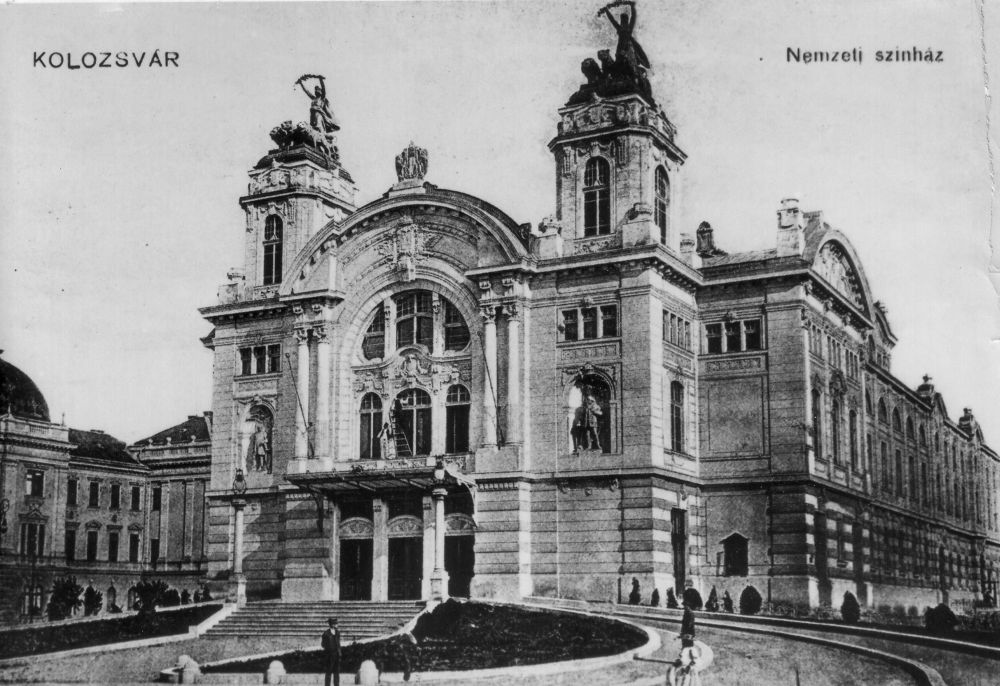
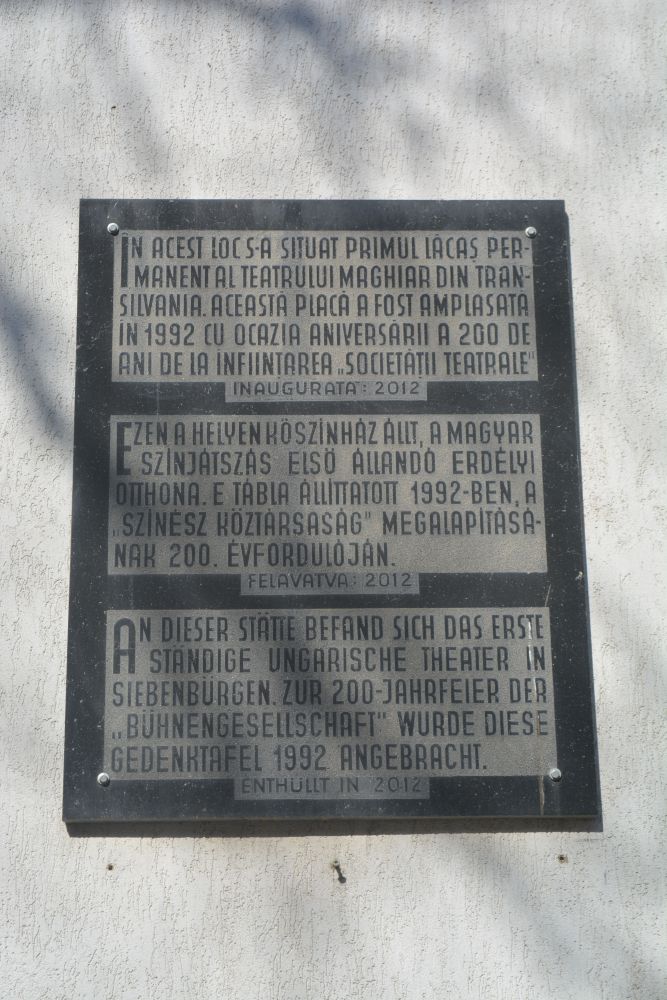
The Theatre in Ştefan cel Mare Square Memorial plaque placed on the building of Casa Universitarilor
Erzsébet Zakariás
[1] The title of László Szentjóbi Szabó's play appears in several versions according to different sources: Korvin / Corvin Mátyás vagy A nép szeretete a jámbor fejedelmek jutalma. In the current context, we used the title that appears on color posters before 1821.
[2] Ferenczi Zoltán: A kolozsvári színészet és színház története (The History of Acting and Theatre in Cluj). Kiadja a Kolozsvári színészet százéves jubileumát rendező bizottság (Published by the committee celebrating the centenial of Cluj theatre), Cluj, 1897.
[3] Káli Nagy Lázár visszaemlékezései. Az erdélyi magyar színészet hőskora 1792—1821 (Lázár Káli Nagy’s Memoirs. The Golden Age of Hungarian Theatre in Transylvania). Third, improved edition, edited by János Lázok, Mentor Publishing House, Târgu Mureş, 2009.
[4] The character descriptions were sourced mainly from Janovics Jenő A Farkas utcai színház című, Singer and Wolfner, Budapest, 1941, as well as Déryné naplójára I-II-III., edited by Bayer József, Singer and Wolfner, Budapest
[5] Déryné naplója/ Déryné Róza Széppataki’s Journal. Prepared for printing by József Bayer, Singer és Wolfner, vol III. part IV. , p.450.
[6] Déryné naplója/ Déryné Róza Széppataki’s Journal. Prepared for printing by József Bayer, Singer és Wolfner, vol II. part IV., p. 237.
[7] Jászai Mari Emlékiratai (Mari Jászai’s Memoirs). Edited by István Lehel, Published by the Royal Hungarian University Press, 1927, Budapest, pp. 31—32.
[8] Janovics Jenő A Farkas-utcai színház (The Farkas / Kogălniceanu Street Theatre), Singer és Wolfner, 1941, p. 155.
[9] The building is the home of the Lucian Blaga National Theatre today
[10] Géza Zichy: Ünnepi nyitány (Festive Overture) / Dániel P. Horváth: Előszó (Prologue) / János Lavotta: Zrínyi nyitány (Zrínyi Overture) who was a conductor at the beginning of the century/Körner: Zrínyi—final scene, that was performed by the aristocrats at the inaugural performance/ László Szentjóbi Szabó: Mátyás király, vagy A nép szeretete jámbor fejedelmek jutalma (King Matthias or The Love of the People as the Reward for Pious Leaders) written in 1792, on the basis of some patriotic texts, the play with which in 1821, the Transylvanian Theater Society began its series of regular performances / Zenekép (Music Scenes) based on the songs of József Ruzitska, who worked as a director at the theater in 1821 / Búcsú (Farewell). Dramatic epilogue, written by Antal Váradi, on the occasion of the closing of the Cluj National Theatre. The poster included the names of all members of the company in 1906.
[11] The festive inauguration of the new theater began with Pongrác Kacsóh's Overture, followed by Janovics' Welcome Speech, and the singing of the Anthem. The evening continued with two pieces written by Ferenc Herczeg, the Színházavatás (Theater Inauguration) and then A bujdosók (The Lurkers), with Jenő Virányi conducting Rákóczi Kéler's overture between the two short pieces.







